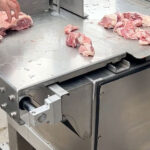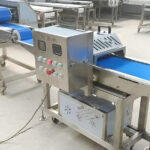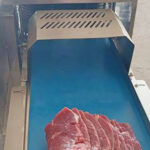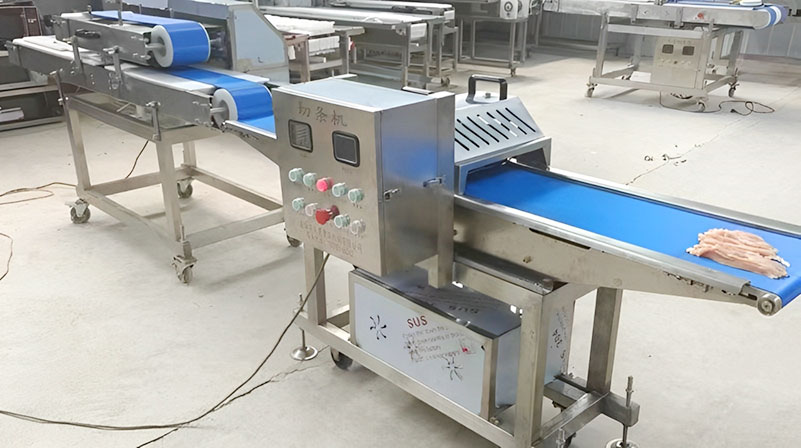工业切割机彻底改变了加工效率,但使用不当的风险工人安全和产品质量. This guide details professional protocols for commercial operations.
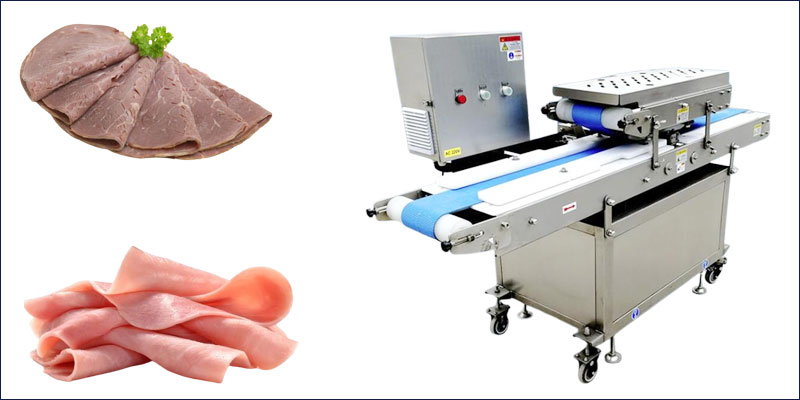
🔧 1. Pre-Operation Setup
电压 & Grounding Check:
Verify power matches machine ratings (220V/380V) and install a leakage protector. For 3-phase systems, confirm blade rotation aligns with markings .
Blade & Component Inspection:
Remove foreign objects from cutting chambers and ensure blades rotate inward (counter-clockwise typically). Test run for 2–3 minutes max to avoid overheating .
Meat Preparation:
Debone thoroughly and cut into ≤40mm x 40mm strips. Frozen meat must be thawed to -6°C or above to prevent blade damage .
⚙️ 2. Step-by-Step Operation
Power On & Stability:
Lock wheel casters on mobile units and place machines on non-slip surfaces .
Feeding Protocol:
Use pusher rods (never hands!) to guide meat into the inlet. For strips/cubes:
Slices: Feed meat flat → collect output
Strips: Re-feed slices rotated 90°
Cubes: Process strips perpendicularly.
Thickness Adjustment:
Rotate the thickness dial (例如。, 2.5–40mm). Industrial models like the ASL-XRQP160 allow on-the-fly changes via control panels.
Shutdown Sequence:
Turn off power → unplug → remove residual meat before disassembly.
⚠️ 3. Critical Safety Rules
Hand Safety:
Never clear jams or adjust blades while powered. Use Kevlar gloves when handling blades.
Electrical Hazards:
Clean only with damp cloths (no water jets!). Circuit components must stay dry.
Emergency Response:
If blades jam or reverse, cut power immediately. Industrial units like Hengfan’s 3KW model include emergency stop buttons.
🛠️ 4. Maintenance for Longevity
Daily Cleaning:
Disassemble blades/combs → wash with >50°C water → dry → apply food-grade oil to prevent rust. Avoid submerging electrical parts!
Weekly Lubrication:
Grease guide rails, pusher rods, and drive shafts using NSF H1 lubricants.
Blade Sharpening:
Use manufacturer-supplied stones. Run sharpeners for 1-2 minutes post-cleaning, checking for burrs.
Long-Term Storage:
Coat all metal parts with oil, bag removable components, and store in low-humidity areas.
💎5. Key Performance Troubleshooting
| Issue | Cause | Fix |
|---|---|---|
| Stuck meat slices | Misaligned blades | Adjust blade gap/spacers |
| Clogged output | Over-tightened pusher plate | Loosen front nut; clear blockages |
| Motor burnout | Rusted gears from inactivity | Manually rotate blades after long storage |
✅结论
Mastering industrialmeat cutting machines ensures worker safety, reduces waste, and extends equipment life. From deboning to dicing, precision hinges on strict adherence to voltage checks, feeding protocols, and lubrication schedules.
🗨️ Have questions? Share your meat processing challenges below!
♻️ Found this useful? Tag a colleague who needs efficiency upgrades!
📩 Contact us for custom machine quotes or OEM support!





